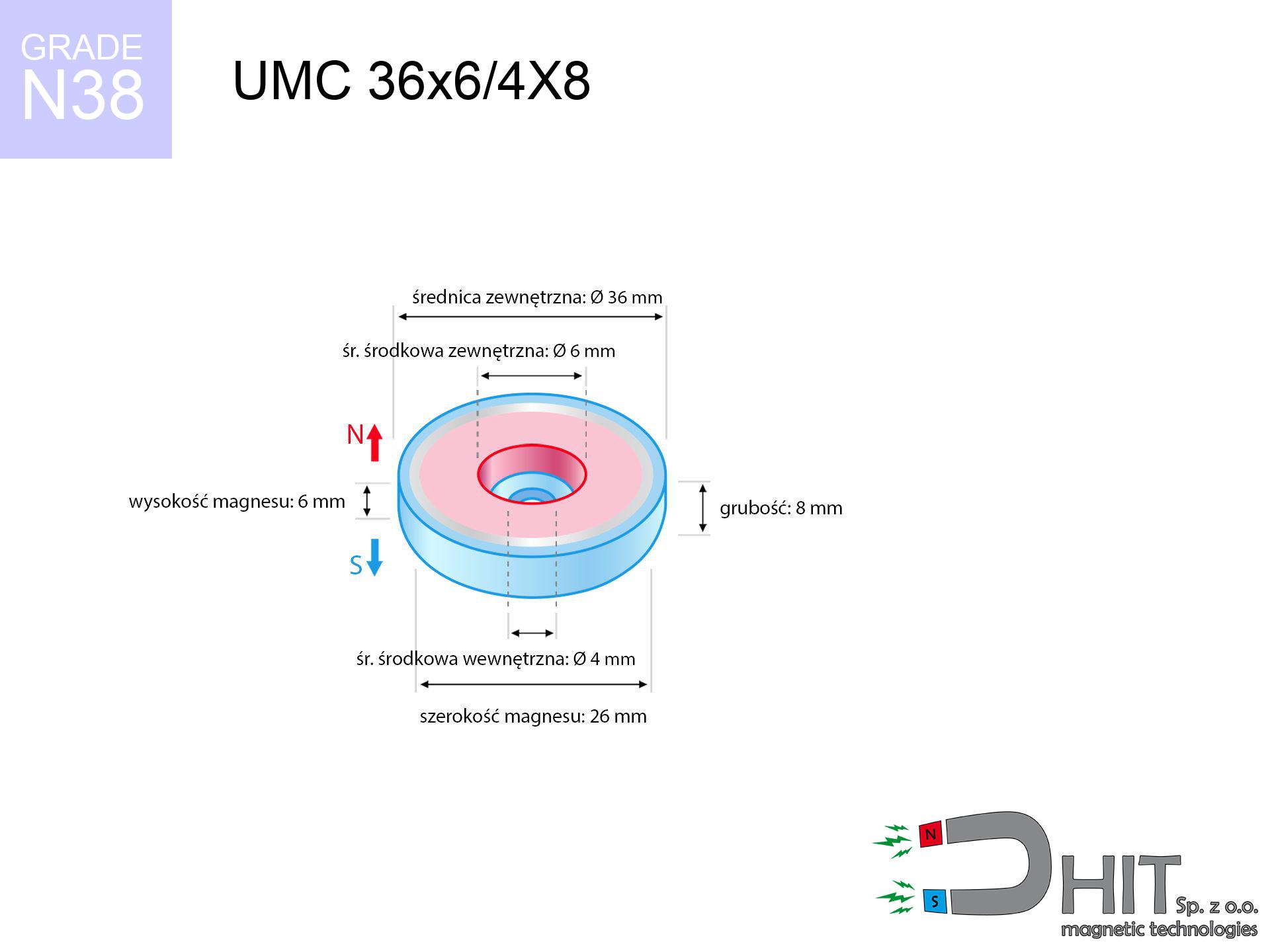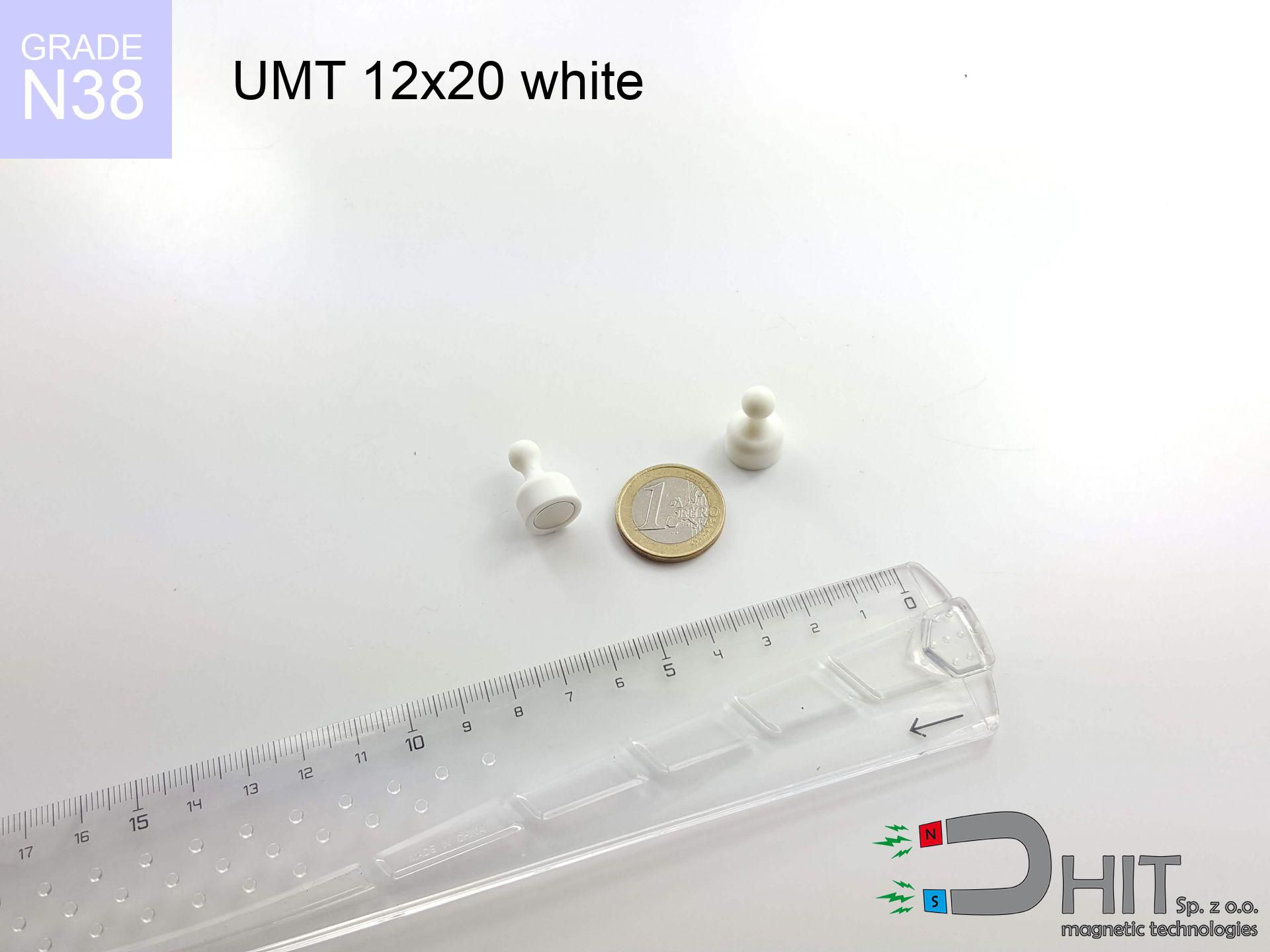UMC 36x6/4X8 / N38
cylindrical magnetic holder
catalog number 320410
GTIN: 5906301814665
external diameter Ø
36
mm [±0,1 mm]
internal diameter Ø
6/4
mm [±0,1 mm]
height
8
mm [±0,1 mm]
capacity ~
29.00 kg / 284.39 N
max. temperature
≤ 80
°C
catalog number 320410
GTIN: 5906301814665
external diameter Ø
36 mm [±0,1 mm]
internal diameter Ø
6/4 mm [±0,1 mm]
height
8 mm [±0,1 mm]
capacity ~
29.00 kg / 284.39 N
max. temperature
≤ 80 °C
21.49 ZŁ gross price (including VAT) / pcs +
17.47 ZŁ net price + 23% VAT / pcs
bulk discounts:
need more quantity?Don't know what to buy?
Call us tel: +48 22 499 98 98 or contact us via contact form on the contact page. You can check the strength as well as the appearance of magnet in our magnetic calculator force calculator
Orders placed by 2:00 PM will be shipped on the same business day.
Specification: cylindrical magnetic holder 36x6/4X8 / N38
Magnetic properties of the material N38
Physical properties of sintered neodymium magnets Nd2Fe14B
Product suggestions
Advantages and disadvantages of neodymium magnets NdFeB.
Apart from immense strength, neodymium magnets have the following advantages:
- They do not lose strength over time - after 10 years, their power decreases by only ~1% (theoretically),
- They protect against demagnetization caused by external magnetic sources extremely well,
- Thanks to the shiny finish and nickel, gold, or silver coating, they have an aesthetic appearance,
- They have very high magnetic induction on the surface of the magnet,
- By using an appropriate combination of materials, they can achieve high thermal resistance, allowing them to operate at temperatures up to 230°C and above...
- Thanks to the flexibility in shaping and the ability to adapt to specific requirements – neodymium magnets can be produced in many variants of shapes and sizes, which amplifies their universality in usage.
- Key role in modern technologies – are used in hard drives, electric motors, medical devices or various technologically advanced devices.
Disadvantages of neodymium magnets:
- They can break as they are fragile when subjected to a strong impact. If the magnets are exposed to impacts, we recommend using magnets in a metal holder. The steel housing in the form of a holder protects the magnet from impacts and also increases its overall strength,
- Magnets lose their power due to exposure to high temperatures. In most cases, when the temperature exceeds 80°C, these magnets experience permanent loss in strength (although it is worth noting that this is dependent on the shape and size of the magnet). To avoid this problem, we offer special magnets marked with the [AH] symbol, which exhibit high temperature resistance. They can operate even at temperatures as high as 230°C or more,
- Due to their susceptibility to corrosion in a humid environment, we recommend using waterproof magnets made of rubber, plastic, or other moisture-resistant materials when using them outdoors,
- The use of a cover - a magnetic holder is recommended due to the limited production capabilities of creating threads or complex shapes in the magnet
- Health risk associated with microscopic parts of magnets can be dangerous, in case of ingestion, which is crucial in the aspect of protecting young children. It's also worth noting that miniscule components of these devices have the potential to be problematic in medical diagnosis in case of swallowing.
Caution with Neodymium Magnets
Magnets should not be treated as toys. Therefore, it is not recommended for children to have access to them.
Not all neodymium magnets are toys, so do not let children play with them. Small magnets pose a serious choking hazard or can attract to each other in the intestines. In such cases, the only solution is to undergo surgery to remove the magnets, and otherwise, it can even lead to death.
Neodymium magnets can demagnetize at high temperatures.
While Neodymium magnets can demagnetize at high temperatures, it's important to note that the extent of this effect can vary based on factors such as the magnet's material, shape, and intended application.
Neodymium Magnets can attract to each other, pinch the skin, and cause significant injuries.
Magnets will jump and also contact together within a radius of several to around 10 cm from each other.
Keep neodymium magnets away from people with pacemakers.
Neodymium magnets generate very strong magnetic fields that can interfere with the operation of a pacemaker. This is because many of these devices are equipped with a function that deactivates the device in a magnetic field.
Avoid bringing neodymium magnets close to a phone or GPS.
Magnetic fields interfere with compasses and magnetometers used in navigation for air and sea transport, as well as internal compasses of smartphones and GPS devices.
Neodymium magnets are the strongest, most remarkable magnets on earth, and the surprising force between them can shock you at first.
Read the information on our website on how to properly utilize neodymium magnets and avoid significant harm to your body and unintentional disruption to the magnets.
The magnet is coated with nickel - be careful if you have an allergy.
Studies show a small percentage of people have allergies to certain metals, including nickel. An allergic reaction often manifests as skin redness and rash. If you have a nickel allergy, try wearing gloves or avoid direct contact with nickel-plated neodymium magnets.
Dust and powder from neodymium magnets are highly flammable.
Avoid drilling or mechanical processing of neodymium magnets. If the magnet is crushed into fine powder or dust, it becomes highly flammable.
Under no circumstances should neodymium magnets be placed near a computer HDD, TV, and wallet.
Neodymium magnets produce intense magnetic fields that can destroy magnetic media such as floppy disks, video tapes, HDDs, credit cards, magnetic ID cards, cassette tapes, or other devices. They can also damage videos, televisions, CRT computer monitors. Remember not to place neodymium magnets close to these electronic devices.
Magnets made of neodymium are delicate as well as can easily break as well as shatter.
Magnets made of neodymium are fragile and will break if allowed to collide with each other, even from a distance of a few centimeters. Despite being made of metal and coated with a shiny nickel plating, they are not as hard as steel. At the moment of collision between the magnets, small sharp metal fragments can be propelled in various directions at high speed. Eye protection is recommended.
Please see the article - What danger lies in neodymium magnets? You will learn how to handle them properly.



![lamellar magnet 40x10x5x2[7/3.5] / N38 ↑ axial lamellar magnet 40x10x5x2[7/3.5] / N38 ↑ axial](https://cdn3.dhit.pl/graphics/products/mpl-40x10x5x27-3.5-miw.jpg)


![magnetic holder with hook 25x8x45 [M5] / N38 ↑ axial magnetic holder with hook 25x8x45 [M5] / N38 ↑ axial](https://cdn3.dhit.pl/graphics/products/umh-25x8x45-m5-cep.jpg)

